Hundreds of kilometers north of the capital Nairobi, lies the vast remote arid lands of northern Kenya. In this post we bring you a mixture of the sights of northern Kenya and a bit of the people who call these places home.
On your way to Lake Turkana the last major town you will come across is Marsabit. Marsabit is a town located in an island of lush highland oasis surrounded by expansive desert wilderness.
.
Marsabit is home to Marsabit national park, a that park skirts a massive extinct volcano known as Mount Marsabit. Marsabit Mountain is a natural phenomenon, born out of volcanic fire and shaped by mist. The mountain’s great mass has created its own ambient ecosystem. Rising like a mirage above the surrounding burning desert, Marsabit is a cool, green, forested realm often swathed in mist.
.
The park was home to Ahmed – an elephant with the biggest tusks ever recorded. Ahmed lived in the national park and was known as ‘The King of Marsabit’. In 1970, in order to protect him from poachers, Kenya’s first president, placed Ahmed under his protection by presidential decree, an unparalleled occurrence in the history of the country making him the only elephant to be declared a living monument. The giant was watched over day and night by two hunters against poachers.
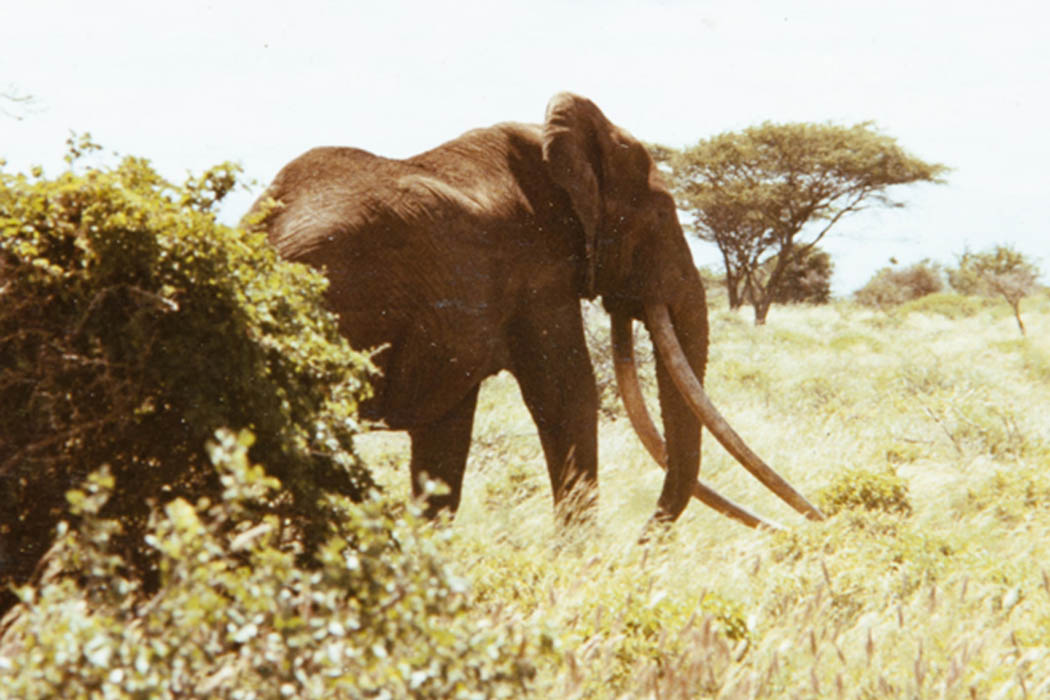 Ahmed the elephant (image credit C. Francombe)
Ahmed the elephant (image credit C. Francombe)
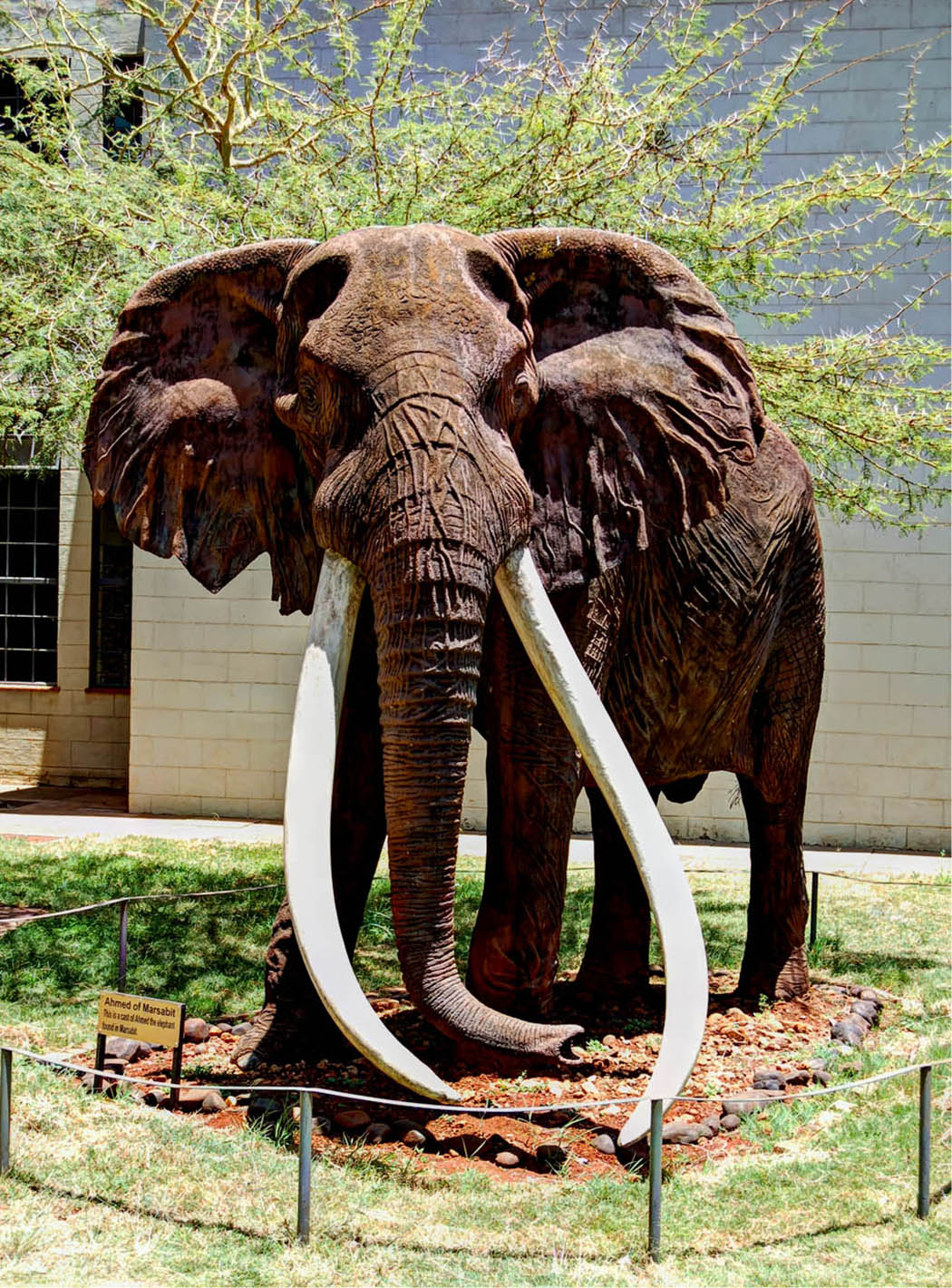 Monument of Ahmed at the National Museum in Nairobi (Image source)
Monument of Ahmed at the National Museum in Nairobi (Image source)
.
The park comprises three crater lakes that are the only permanent surface of water in the region and that provide habitat for a variety of bird life.
.
Once you go past Marsabit town you will encounter the Chalbi Desert is a huge area of around 100,000 sq km of virtually flat sandy desert, to the east of Lake Turkana. The Chalbi Desert is amazing in the amount of contrast you can discover on a relatively flat and barren piece of land.
The Chalbi Desert is home to the Gabra (also written Gabbra or Gebra). The Gabbra are pastoralists with a strong attachment to camels and are closely associated with the Oromo, and their non-nomadic neighbors, the Borana.
Women wear the ‘kanga’, thin pieces of brightly colored cotton, and a head cloth. Gabra men usually wear turbans and white cotton robes. Gabbra homes are called mandasse and although the men decide when to migrate, women pack and unpack the camp site before and after migration. In fact, it’s who women “own” the huts and have complete authority over them.
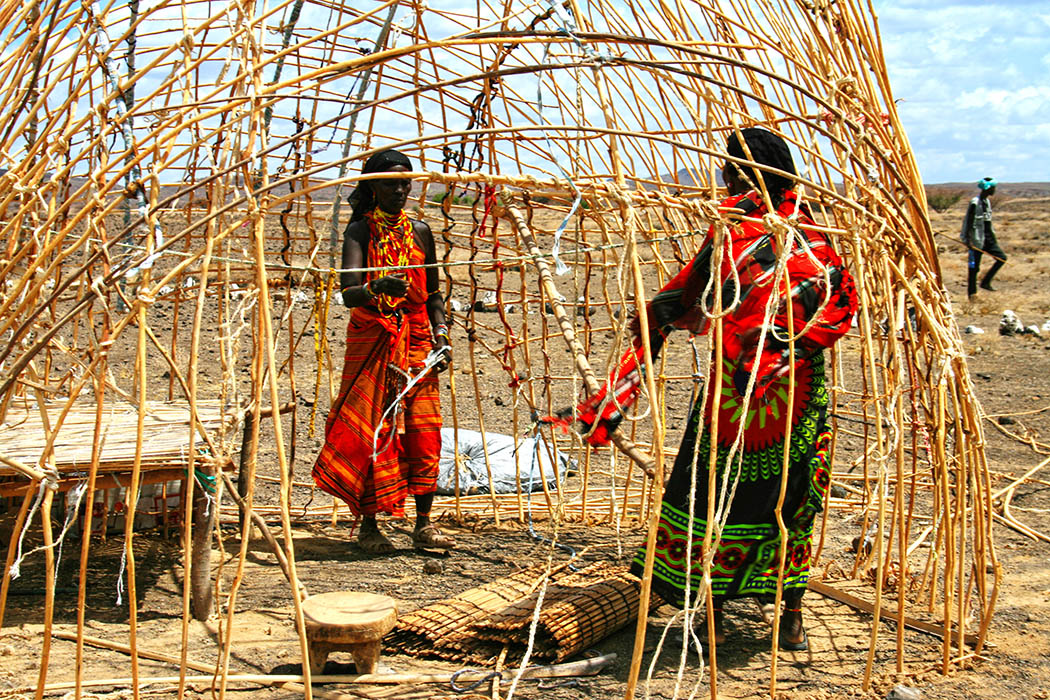 Gabbra women constructing a hut
Gabbra women constructing a hut
If you journey across the Chalbi you will eventually come across Lake Turkana. It was once known as Lake Rudolf (Count Samuel Teleki and Lieutenant Ludwig von Höhnel visited the lake in 1888 and named it after the crown prince of Austria) and is the worlds largest permanent desert lake. Lake Turkana once formed a larger body of water drained by the Sobat River into the Nile River.
.
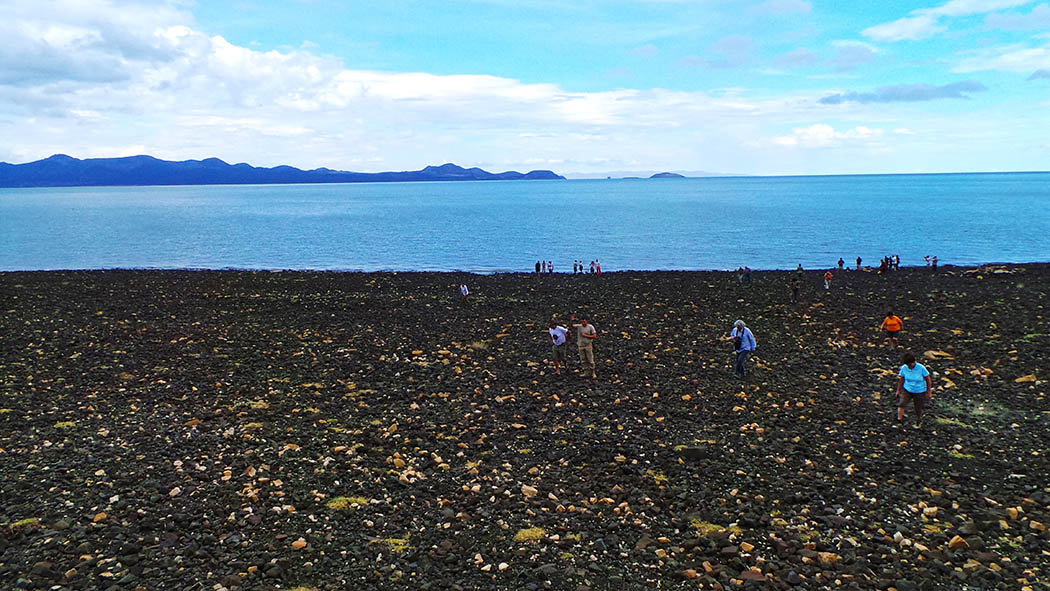 Shores of Lake Turkana at Loiyangalani
Shores of Lake Turkana at Loiyangalani
.
.
Six Major Ethnic groups live adjacent to the eastern side of Lake Turkana. These are the Daasanch,Gabbra,Turkana,Elmolo, Renddile and the Samburu. The Daasanach (meaning ‘People from the Delta”) are an ethnic group of Ethiopia, Kenya and Sudan are a pastoral people by tradition. Majority of the tribe are found in the Omo Valley in Ethiopia, but a few are found in Kenya on the northern shores of Lake Turkana.
A group of Daasanach girls
The Samburu on the other hand are a Nilotic people that are related to but distinct from the Maasai. The Samburu are semi-nomadic pastoralists who herd mainly cattle but also keep sheep, goats and camels.
The Samburu Members of the moran age grade (i.e. “warriors”) typically wear their hair in long braids, which they shave off when they become elders.
.
 Samburu women at the top of Mt. Kulal
Samburu women at the top of Mt. Kulal
Both Samburu men and women dress in brightly colored traditional shukas, which they wrap loosely around their bodies. Samburu men also dye their hair with red ochre, while the women adorn themselves in beautiful, multi-beaded necklaces and other traditional jewelry. Samburu warriors, or morans, keep their long hair in braids and dress in more colorful attire than other members of the tribe.
The Samburu also live atop Mount Kulal, Mt Kulal is an eroded-down extinct volcano located in northern Kenya, just east of Lake Turkana. The mountain has an elevation of 2,285 metres (7,497 ft).
.
Mount Kulal is the centrepiece of the Man and the Biosphere (MAB) reserve of the same name, which is one of six MAB reserves in Kenya. The United Nations Educational, Scientific and Cultural Organization (UNESCO) designated it as a MAB reserve in 1979. Mount Kulal forest, part of the reason that Mount Kulal has been deemed a UNESCO Man and the Biosphere Reserve. Surrounded by deserts, this unique forest traps moisture, contributing to the humidity and cool evening temperatures on the mountain
.
.
.
50 kilometers (31 mi) west of Mount Kulal you will come across the lakeside town of Loiyangalani. It is home to Turkana people and was founded near a freshwater spring in the 1960s. The shore of Lake Turkana is home to the El Molo. The El molo is the smallest tribe in Kenya with a population of about 4,000.
.
Bordering Lake Turkana in the east are the Turkana, a Nilotic people native to the Turkana District in northwest Kenya.
Turkana men dye their hair with special colored soil, while the women adorn themselves with traditional jewelry and beaded necklaces. A woman’s social status or class determines the quantity and style of jewelry she wears
.
.
.
The Watta are one of the smallest tribes in Kenya . The Watta are classified as a tribe based on their hunting and gathering strategy. They are closely related to the Gabbra and Borana and are sometimes considered to be a caste of the Borana.
.
 Watta men performing a dance which involves them stomping on a dry camel skin.
Watta men performing a dance which involves them stomping on a dry camel skin.
Have you been to Northern Kenya?
This week I will be linking up with;
1. Reflections enroute #wkendtravelinspiration
2. Adelina’s Pack Me To in #SundayTraveler
3. Noel Morata’s Travel Photo Mondays
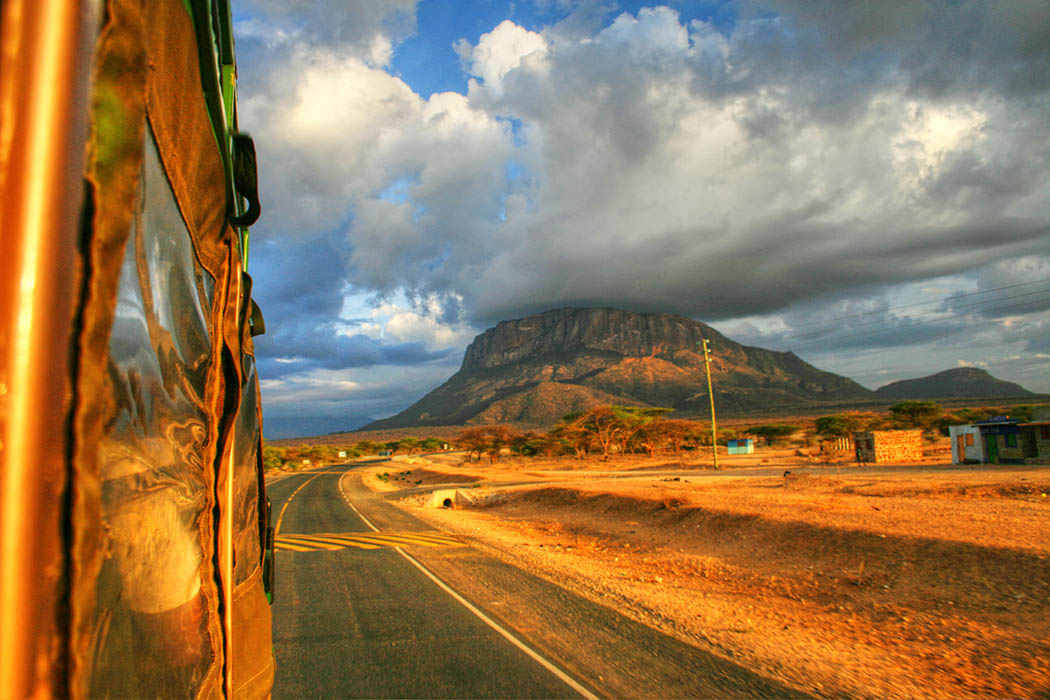
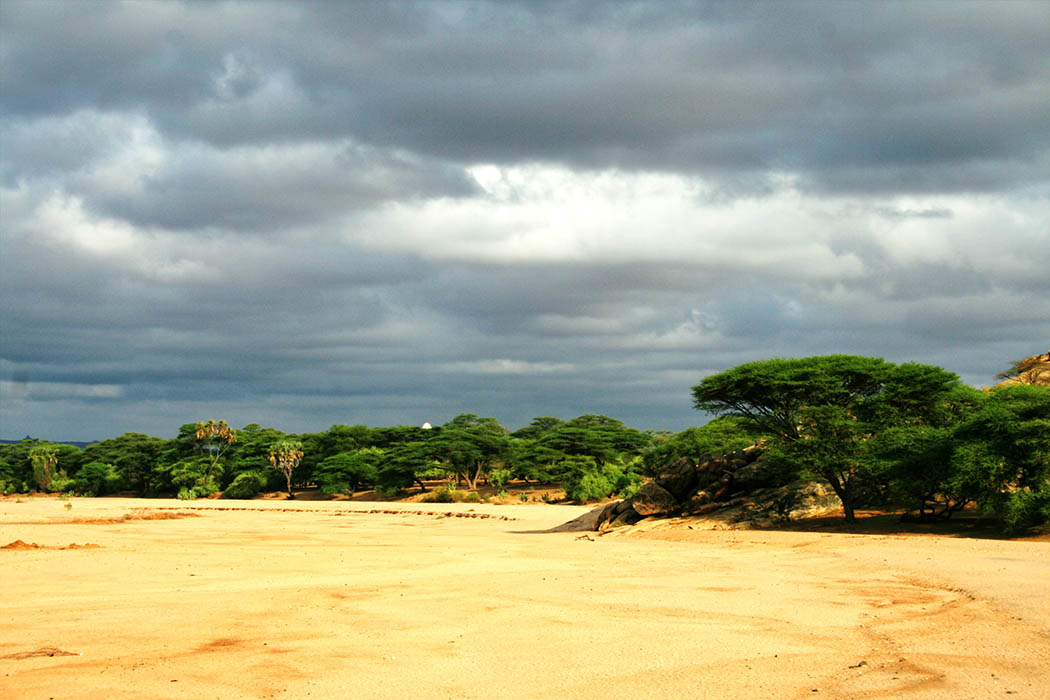
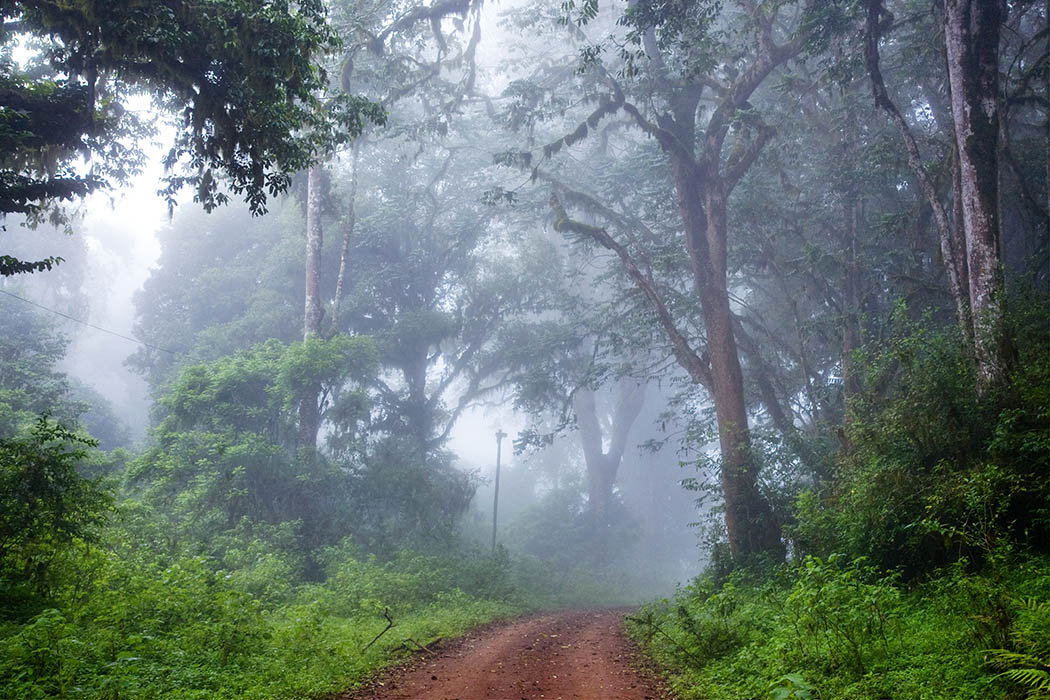
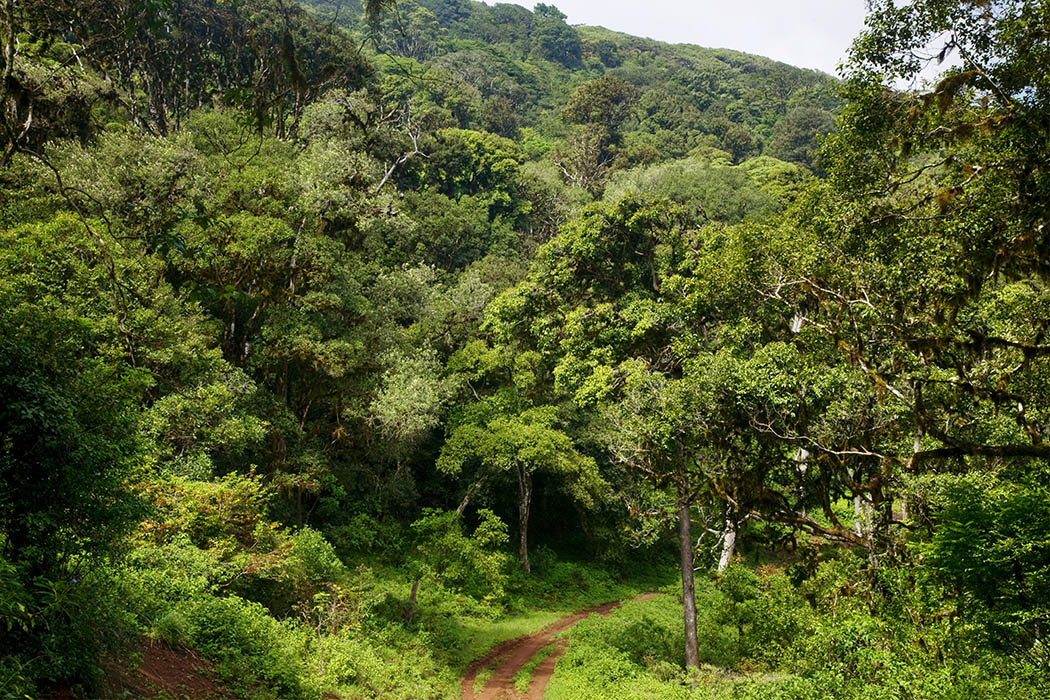
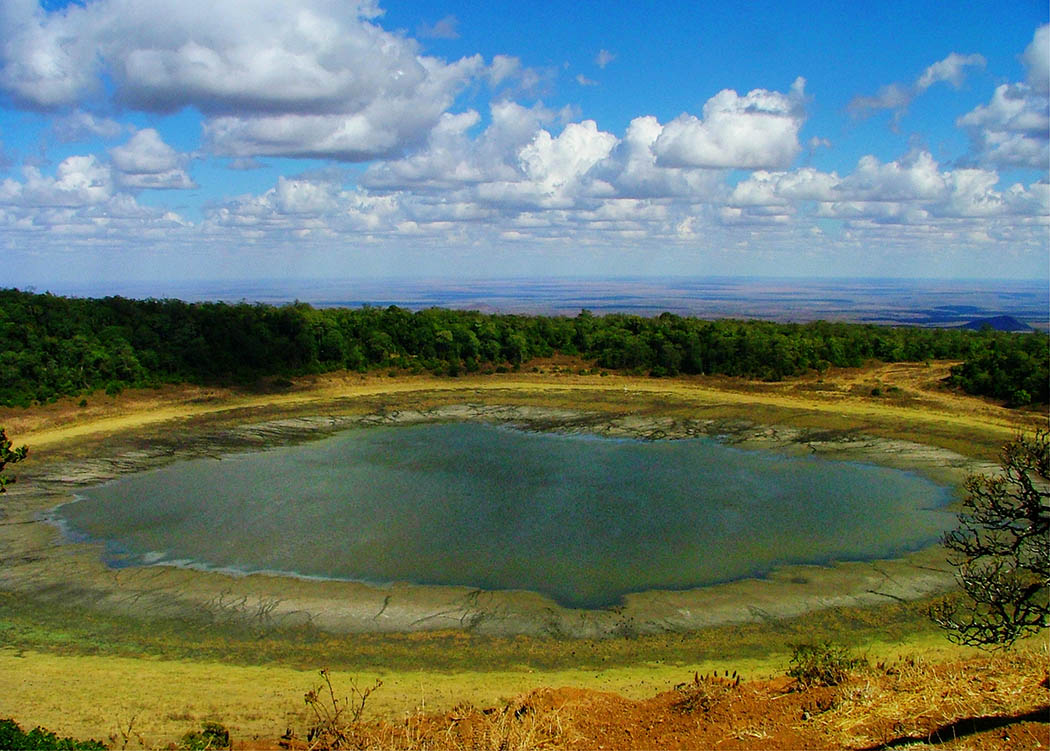
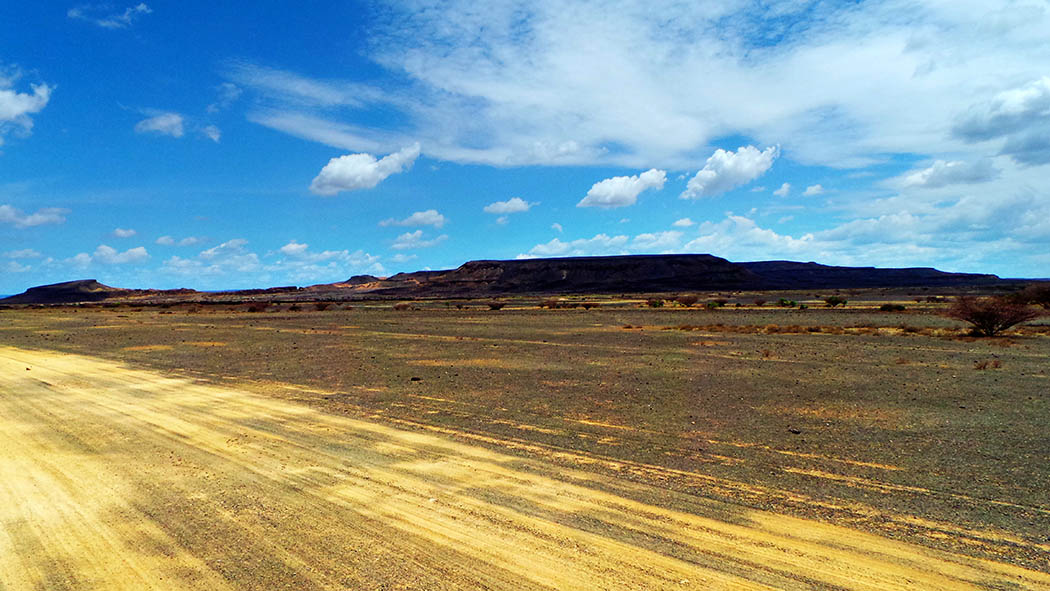
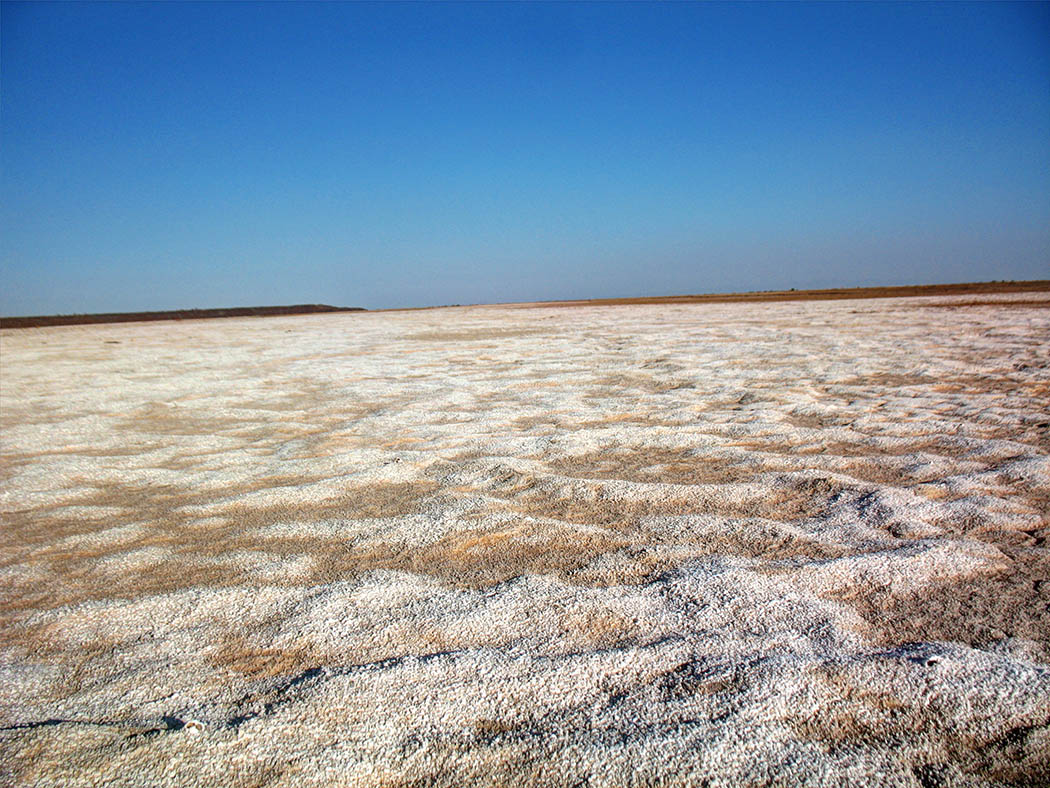

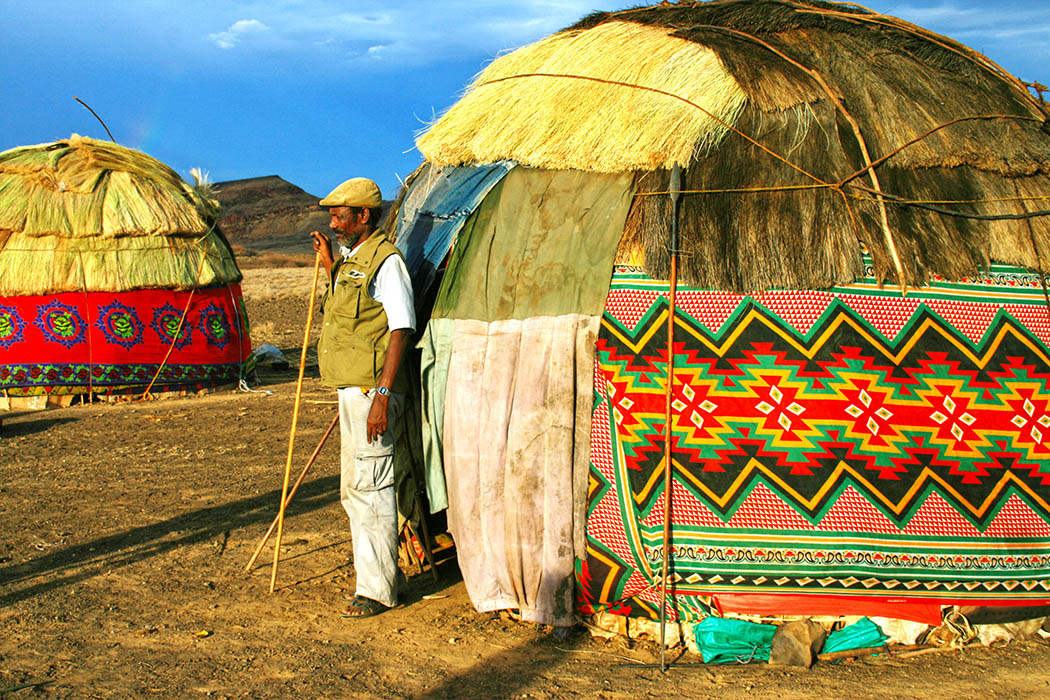
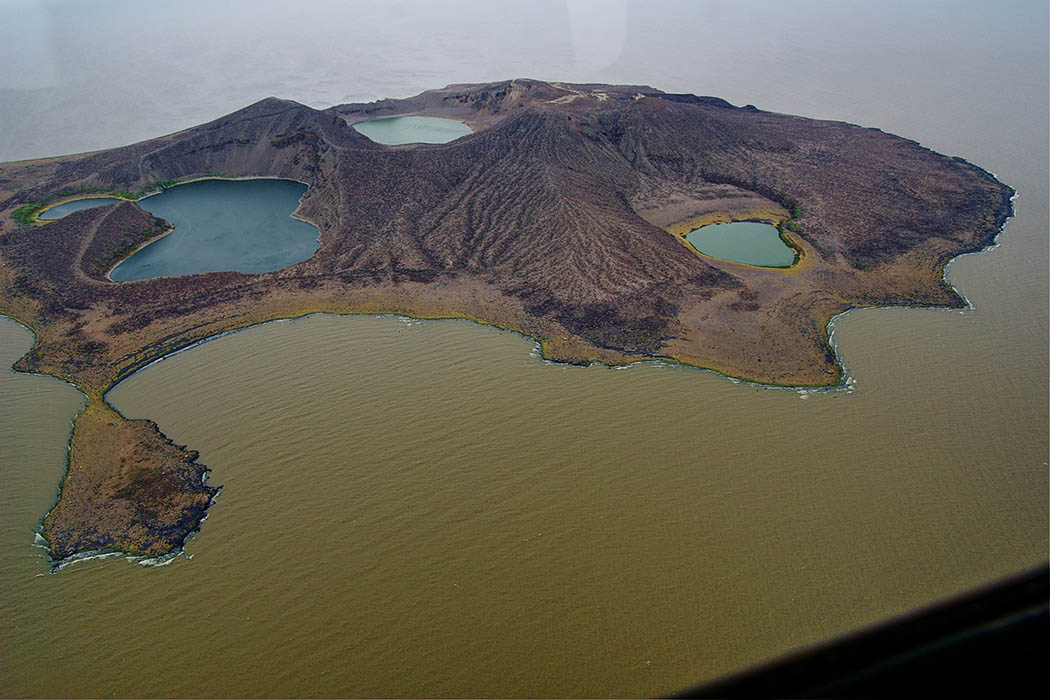
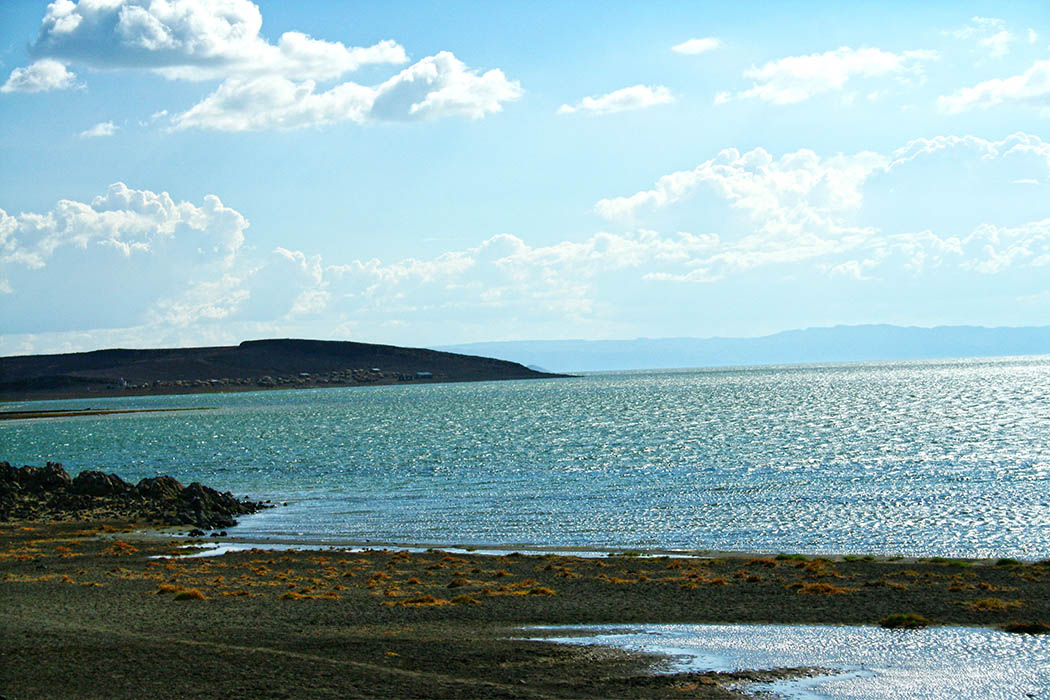
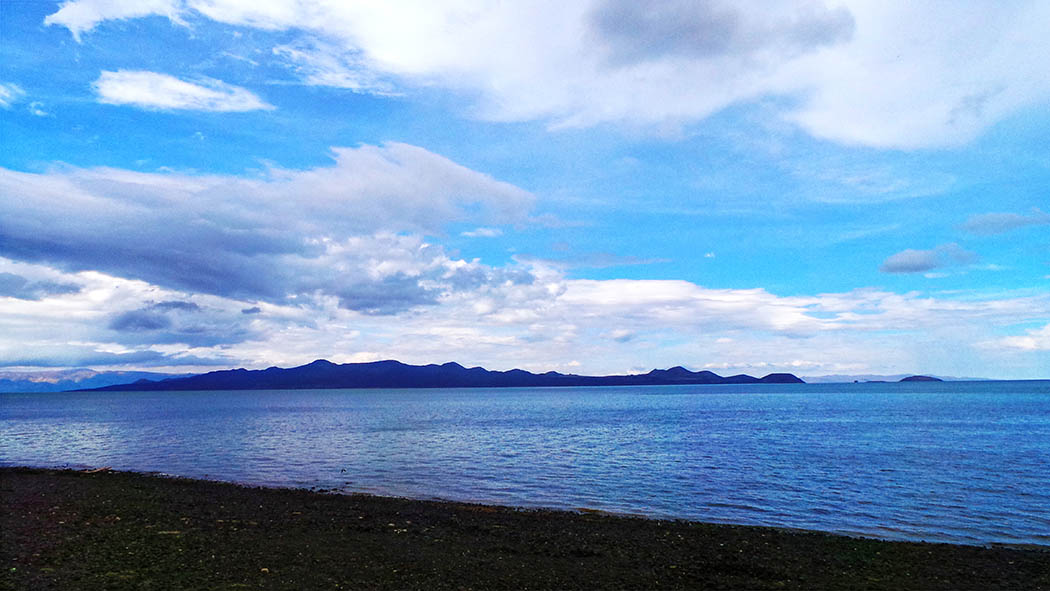
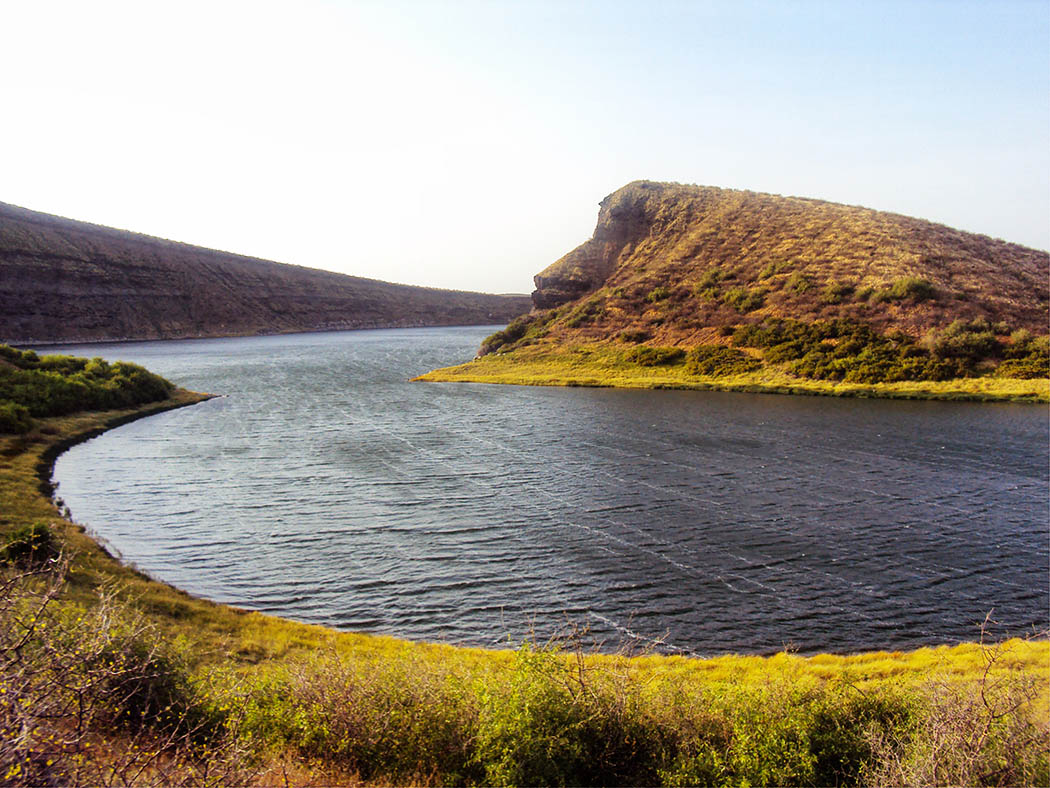
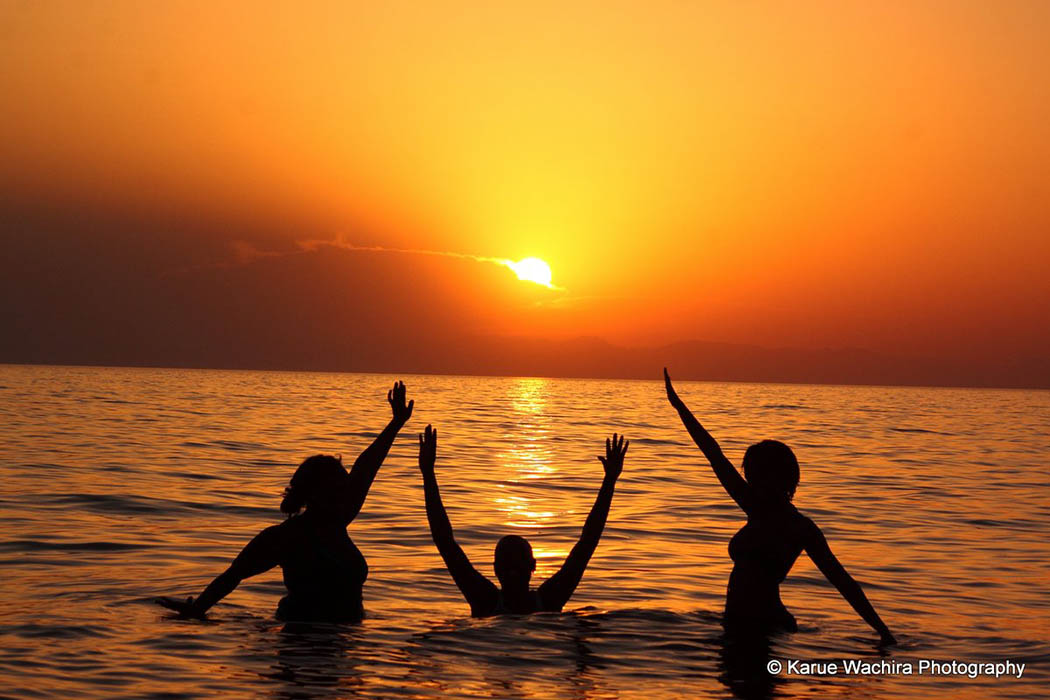
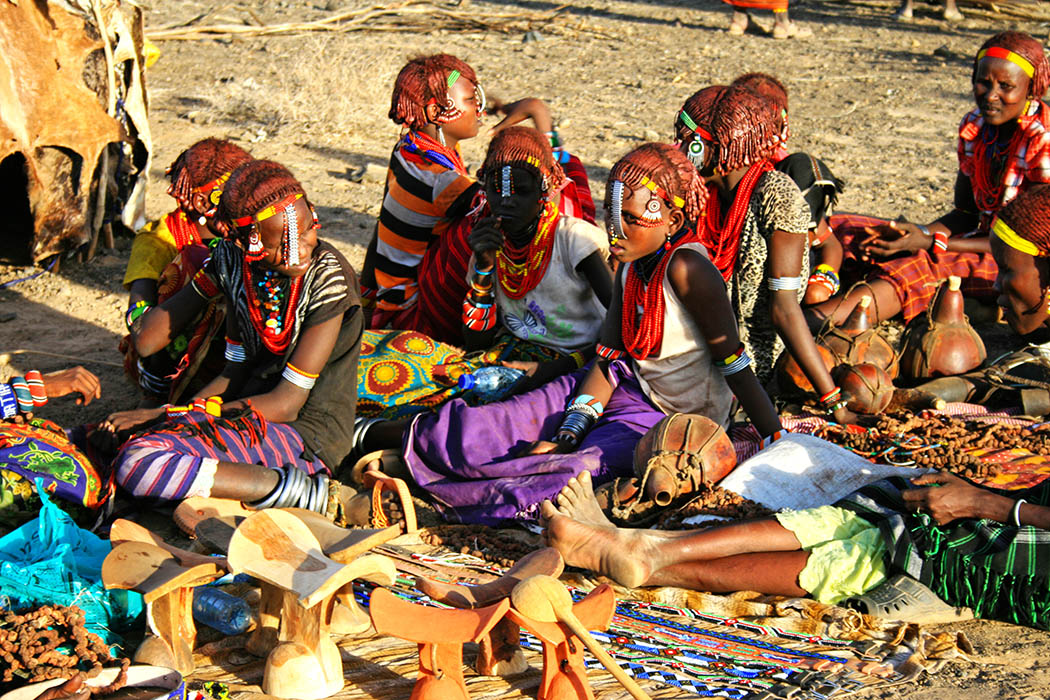
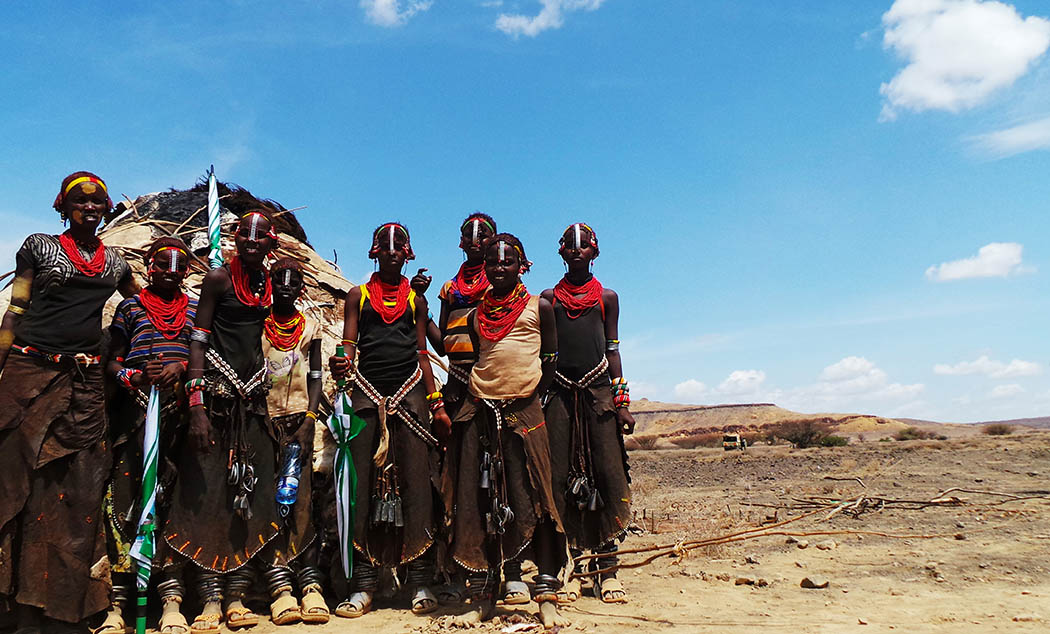
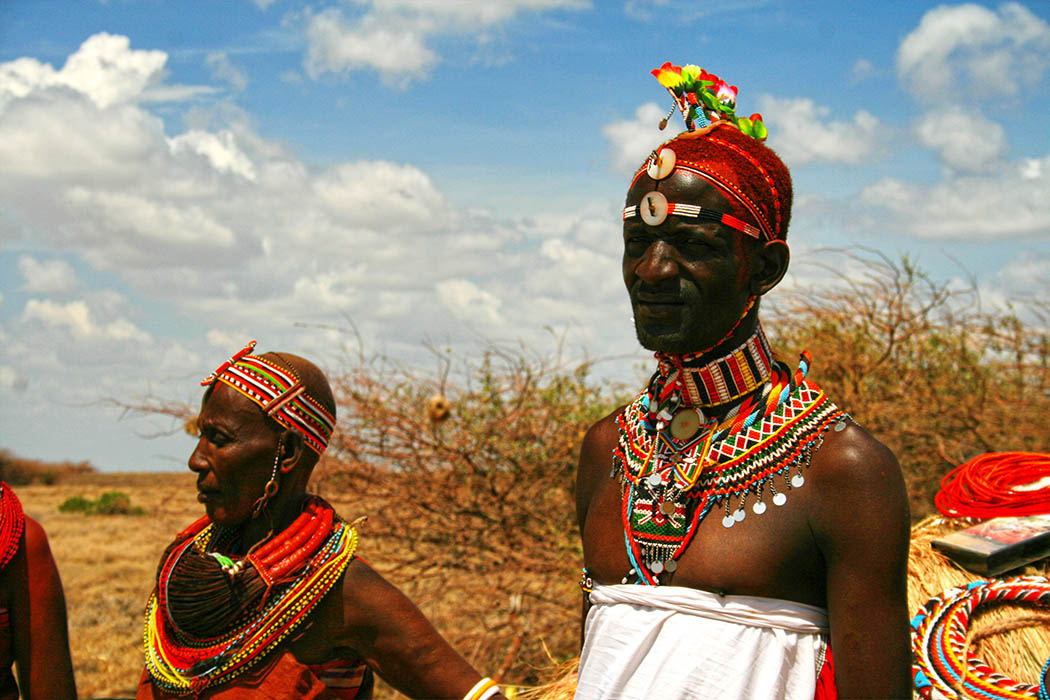
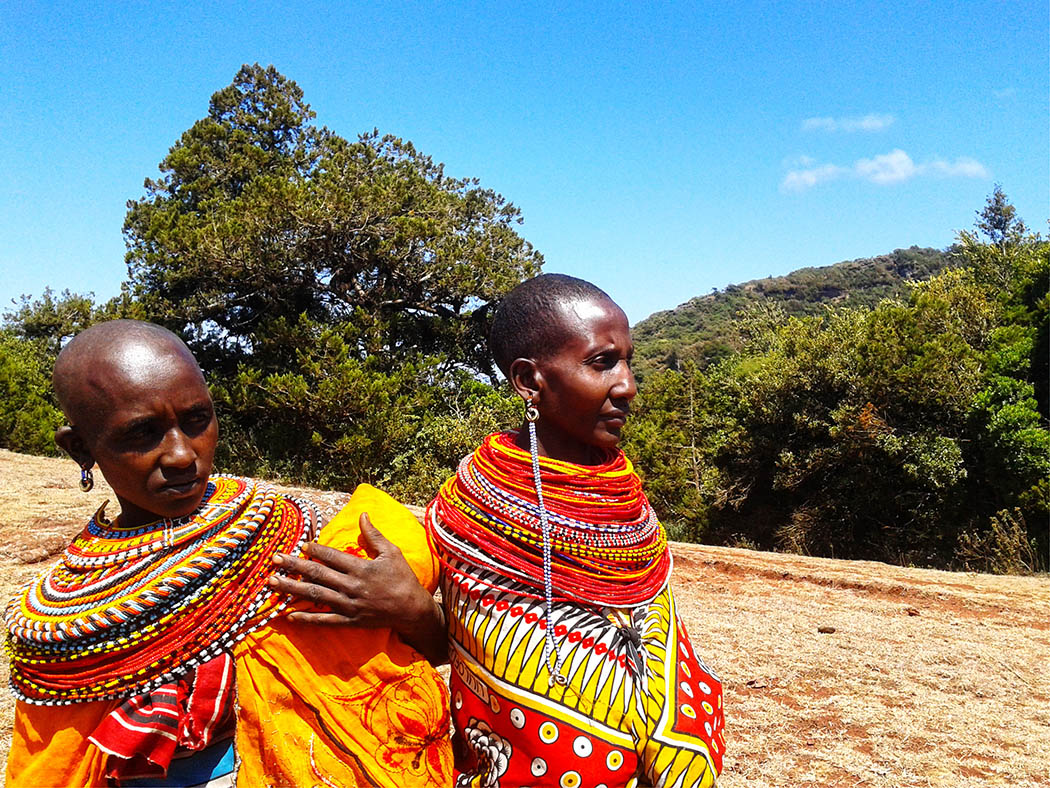
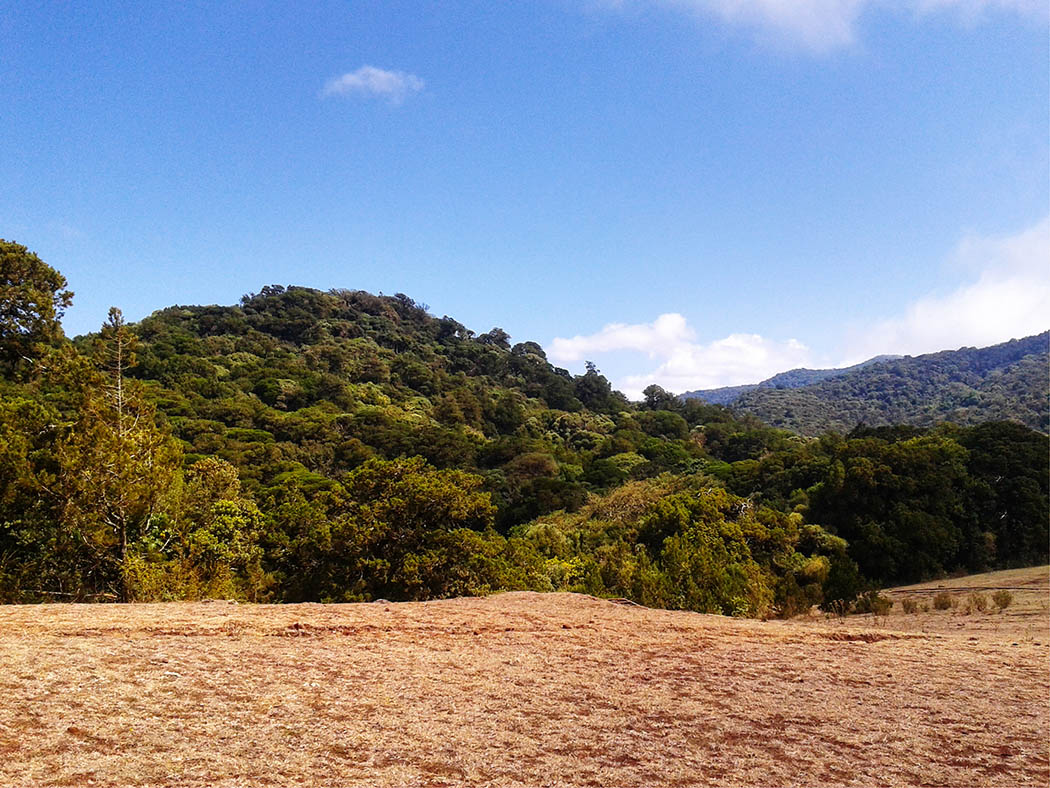
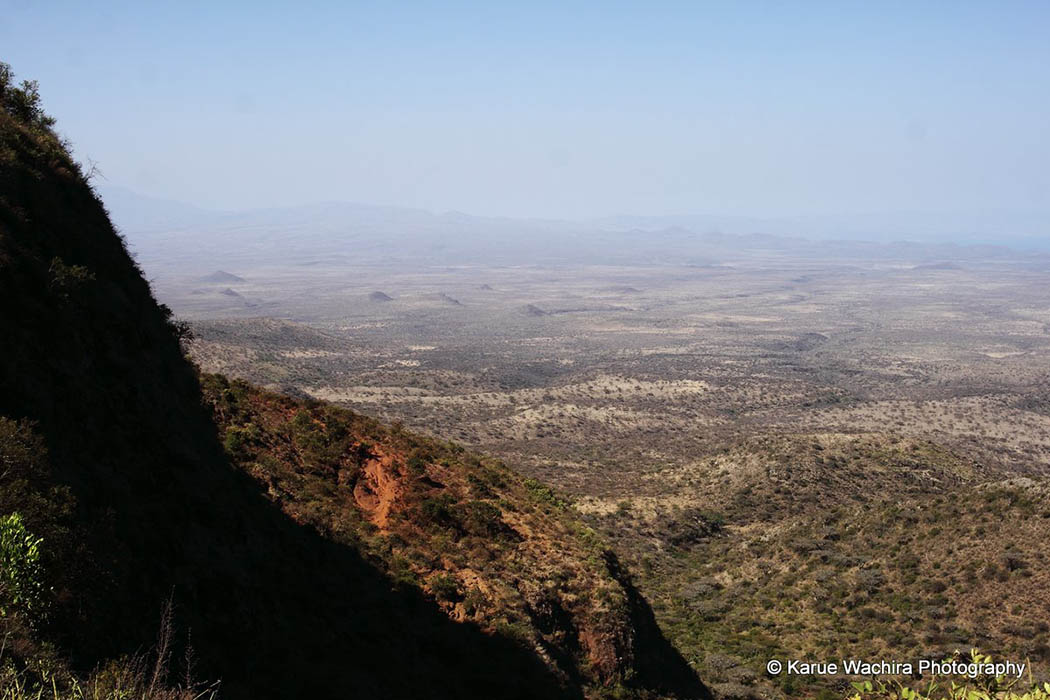
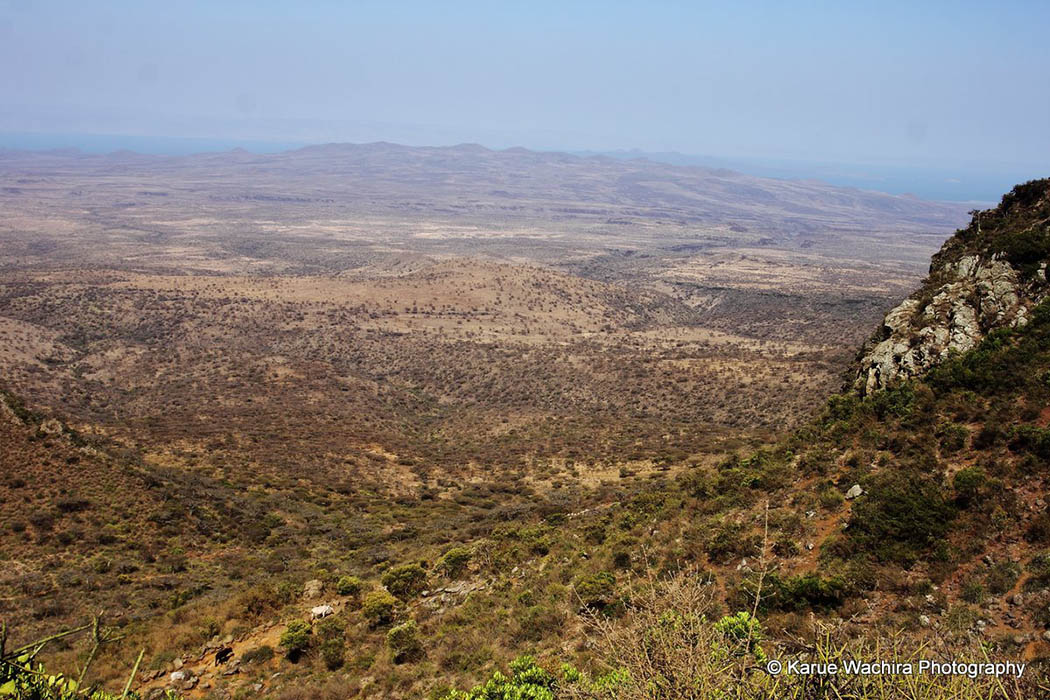
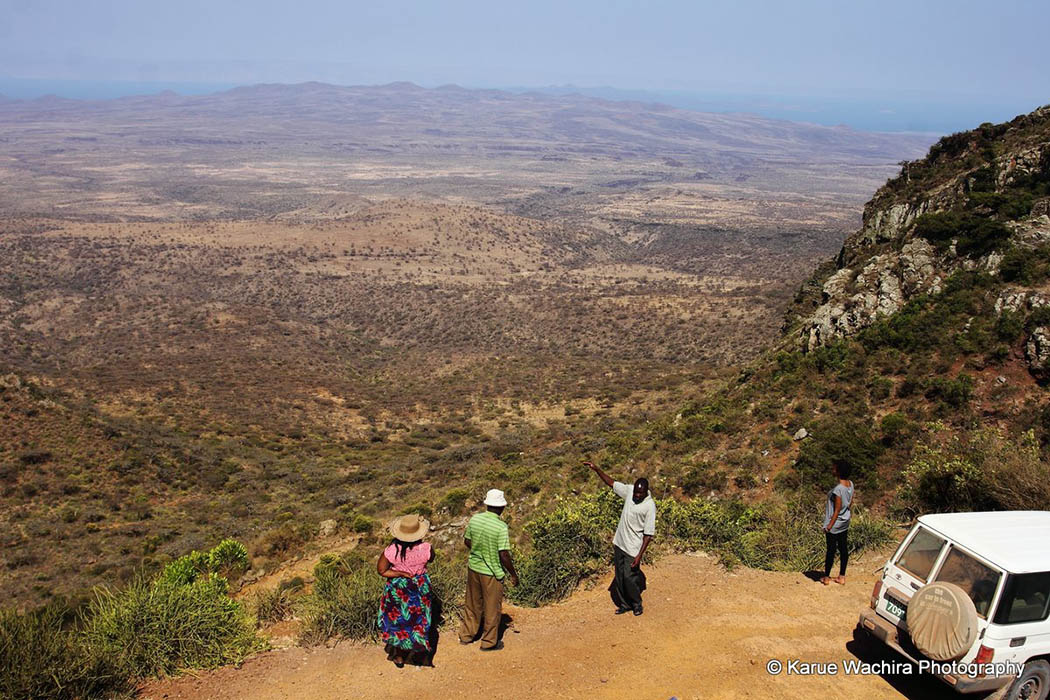
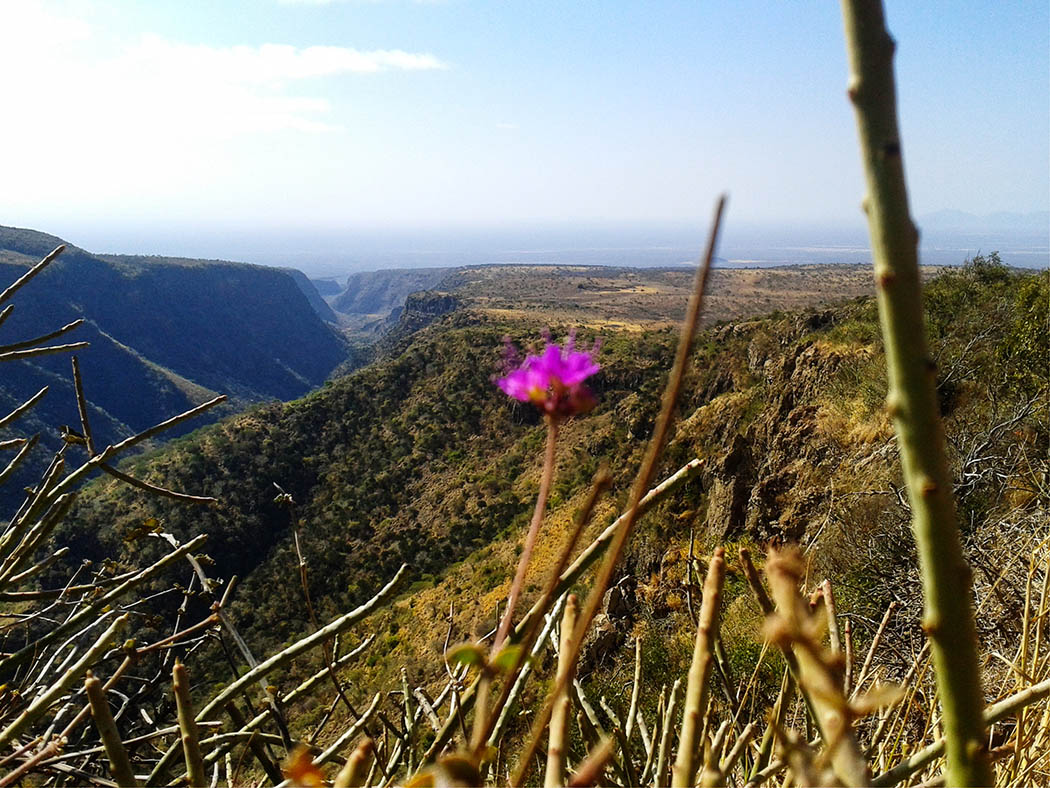
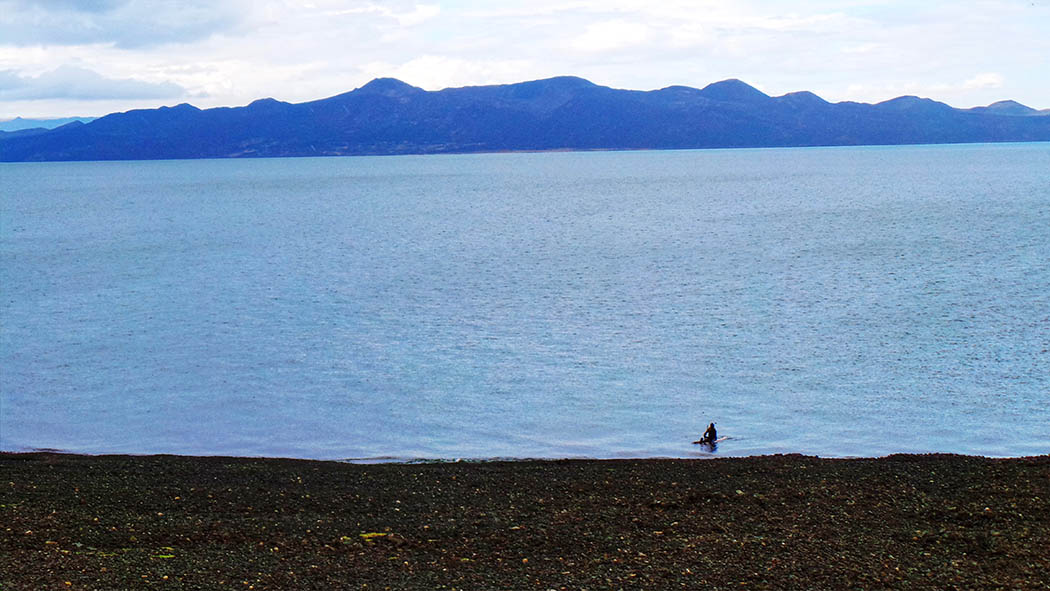
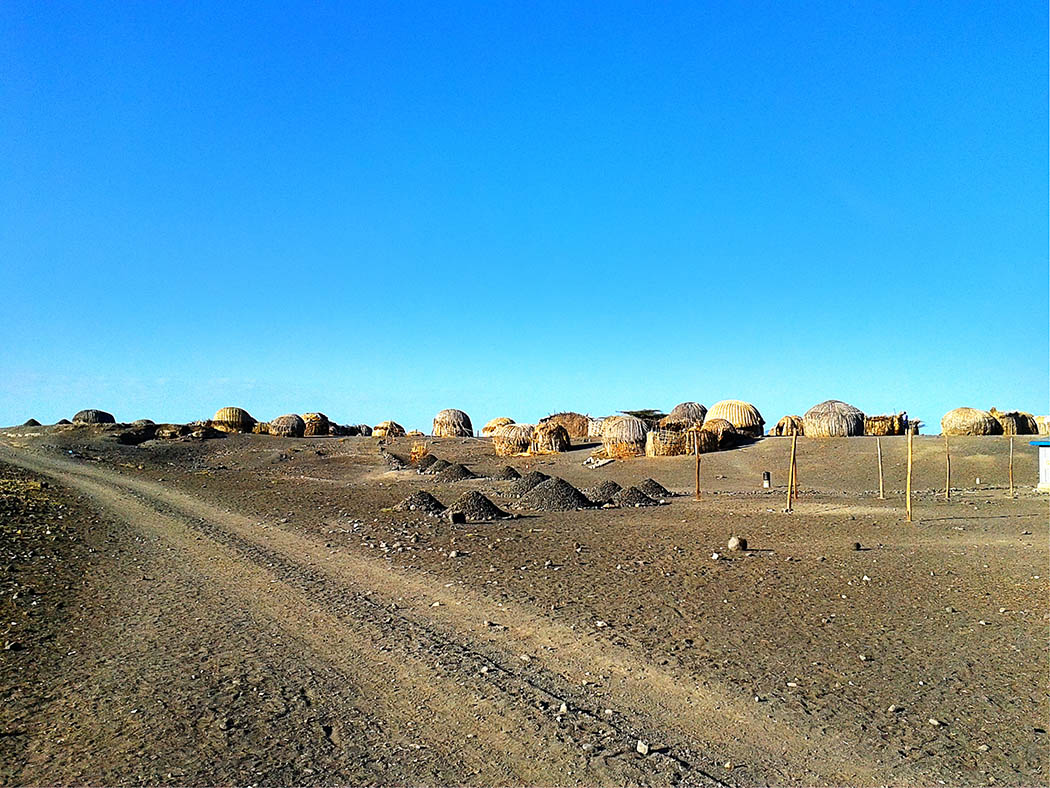
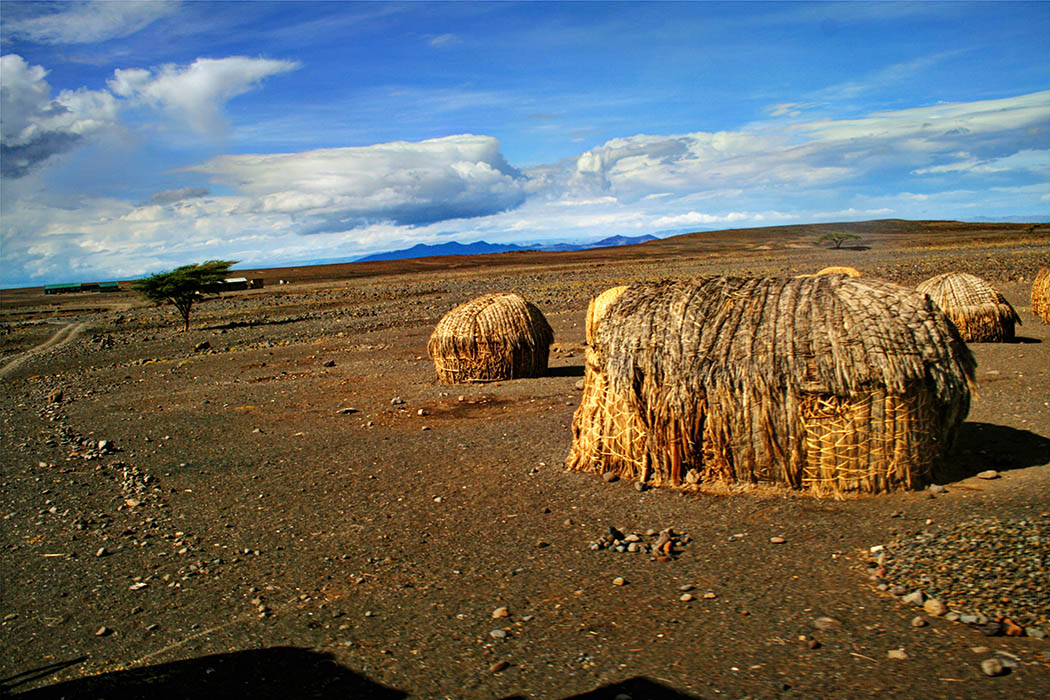
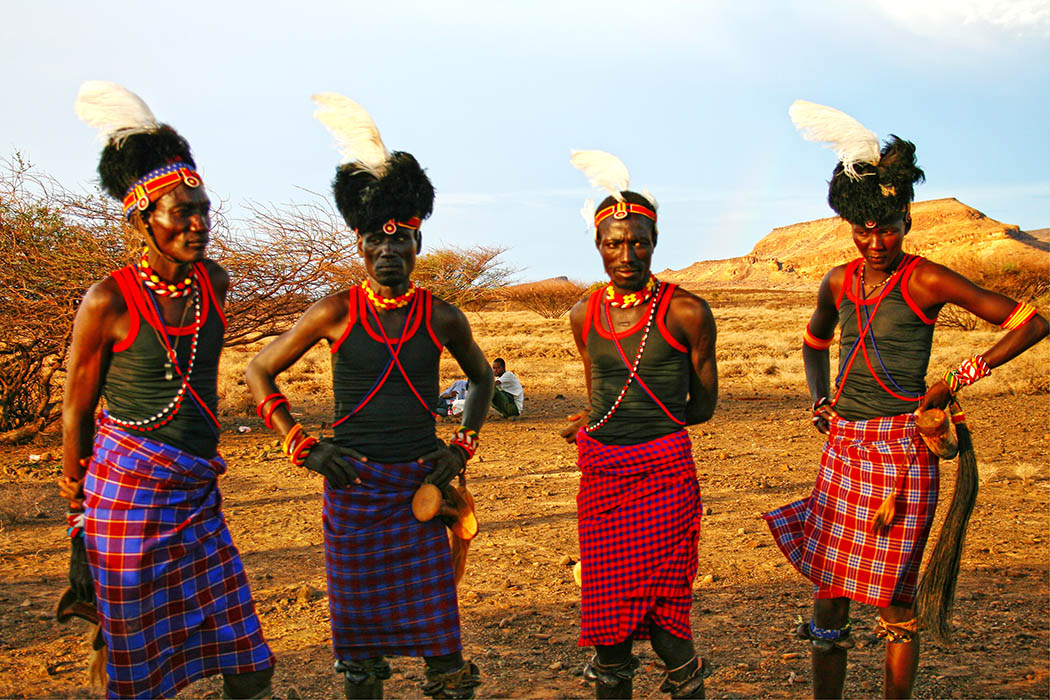

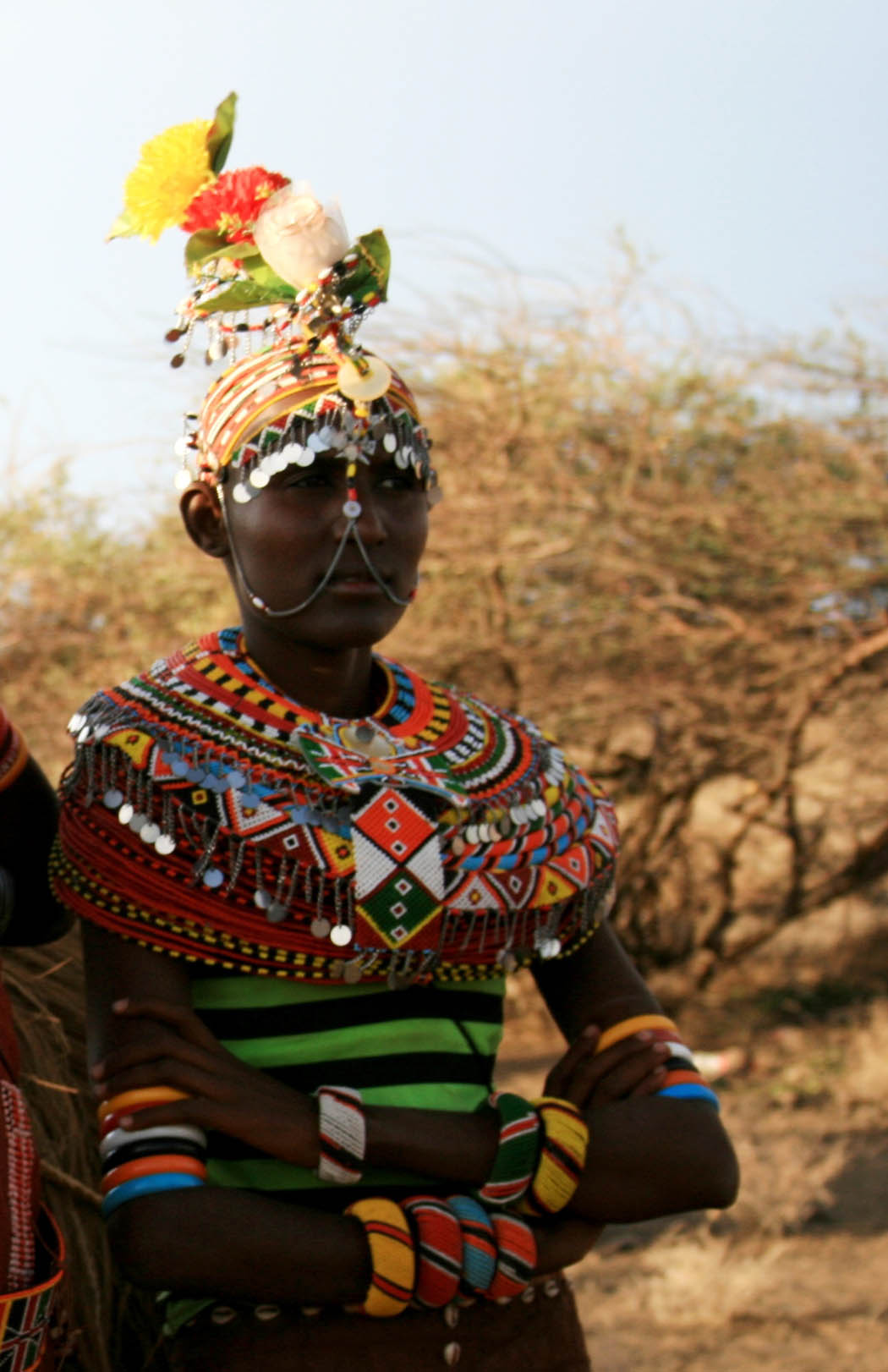

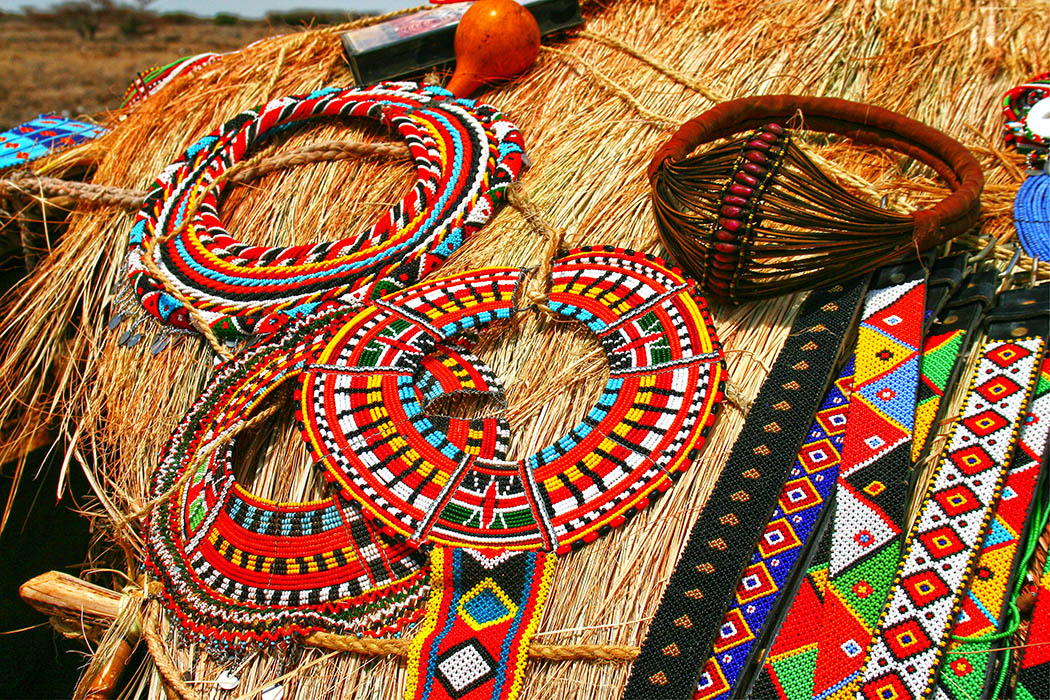




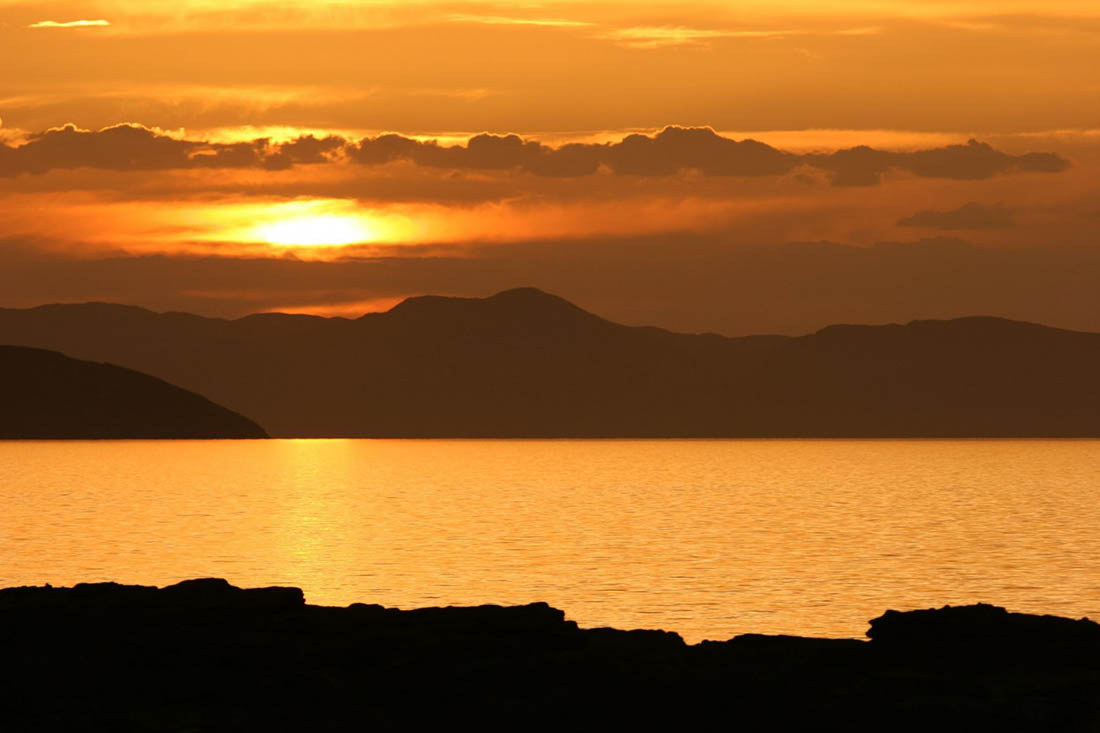
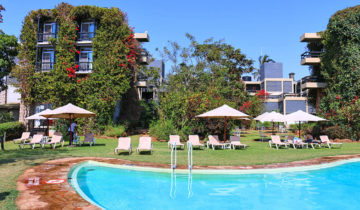
25 Comments
Stunning, I would love to visit all these colorful tribes, is this their daily wear or is it mostly for show and picture taking? Gorgeous photos btw.
In some of the photos they were dressed just for the occasion (they were part of a cultural village) but outside of towns you will find majority of the people in their traditional clothing. e.g the 2 Samburu ladies at the top of Mt. Kulal.
Rachel, Thank you for posting something I’ve never read about before. I have yet to make it to Kenya, and am thinking soon! But now, I would definitely love to include this area north of Nairobi. Your photos are stunning. I love the landscapes and the colors! Thanks again for linking to Weekend Travel Inspiration!
[…] Rising like a mirage above the surrounding burning desert, Marsabit is a cool, green, forested realm often swathed in mist. . Marsabit Forest The park was home to Ahmed an elephant with the biggest tusks ever recorded. Ahmed lived in the national park and was known as The King of Marsabit. In 1970, in order to protect him from poachers, Kenyas first president, placed Ahmed under his protection by presidential decree, an unparalleled occurrence in the history of the country making him the only elephant to be declared a living monument. For the original version including any supplementary images or video, visit http://www.safari254.com/northern-kenya-people-places/ […]
[…] The Chalbi Desert is home to the Gabra (also written Gabbra or Gebra). The Gabbra are pastoralists using a strong accessory and therefore are strongly from the Oromo, as well as their non- nomadic neighbors. Females wear the kanga, slim pieces of colorful cotton, plus a head fabric. Gabra men frequently wear turbans and bright cotton robes.Gabbra houses are termed mandasse and girls pack and unpack the campsite before and after even though the guys determine when to move. Infact, its who girls possess the sheds and also have comprehensive authority. . for Your unique type including any additional photos or video, visit http://www.safari254.com/northern-kenya-people-places/ […]
Amazing colors…
Rachel these photos are really spellbinding. The first one is spectacular. I love the colour of the clothes and the huts.
Rachael – beautiful, beautiful images of beautiful, beautiful people! I love this post. I love all of the beautiful jewelry too. The Daasanach girls are absolutely gorgeous! And I also love the misty image of Marsabit – WOW! Kenya gets more and more beautiful with each post you share!
Amazing photos! These are all so captivating.
Wow, the photos I couldn’t even tell this is my country..the bead work impressive…maybe I need to add Nothern Kenya to my bucket list?
Awesome picture as usual, having followed the blog for quite a while, i now have Northern Kenya on my bucket list.
Btw, those Ahmed tasks are massive !!!
It is one of the most underrated tourist locations in Kenya. Definitely go visit.
I love the photos, the lighting is just brilliant. Very informative. Northern Kenya has been on my list for a while I just need to get there. Which tribes in northern Kenya do the women walk topless? or that time has passed?
I actually did see a couple of topless women but they’re a rarity.I think they were Samburu.
Wow – what magnificent shots of the lush and majestic scenery and the beautiful people!
Wow Rachel, these photos are amazing!!! I love this post, espcecially because all the infomration you shared are new to me from the stunning Masarbit to Ahmed to he beuatiful ethnic groups. I’m so fascinated that a lot of ethnic groups live such a very intact traditional life. I’d love to visit Northern Kenya someday and learn more about them. Thank you for my new education today.
Fascinating post, Rachael! The Gabbra remind me of the Afar in northern Ethiopia/Djibouti as they have similar huts and lifestyles. The colors and landscapes of this part of Kenya are stunning – hope I can get there soon!
Thank you for introducing me to a part of the world I knew very little about. Your photos really tell a colorful story. What an interesting place. I was glad to read the elephant was protected, sad though that is has to be. It is the bright colors and the neck beads that really captivated me.
The first picture of Mt Ololokwe left me speechless! Absolutely amazing! These kids look adorable wearing their tribe clothes.
[…] her recent post, Rachel of Safari 254 blew me away with her gorgeous images of the people and places of Northern Kenya. I grow more and more intrigued by Kenya with each post […]
Northern Kenya is indeed beautiful. Regards, Peter Oluoch, http://dvcaf.uonbi.ac.ke
What a great collection of photos from a spectacular place, Rachel! Love that first photo. This was such an informative post especially about the Turkanas. Each of your post is so inspiring and such a learning experience about Africa. I hope to visit someday soon.
I really liked reading about all the tribes and seeing their photos of their clothes and homes. That area is beautiful. I like the diversity of the landscape — salt pans in the desert, misty Marsabit Mountain, and that cool island with mini lakes in Lake Turkana. Those tusks on Ahmed are really long indeed.
What a fantastic set of images and such a diverse landscape – 0ne I knew nothing about before.
Ibrahim Bonaya Ware. Tana River County in Coastal Region of Kenya. Watta tribe is not related to Gabra nor Borana tribes. We are found in Marsabit, Isiolo, Kwale, Taita Taveta, Kilifi and Tana River Counties.